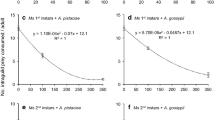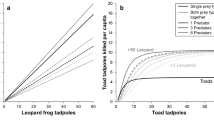Summary
Adult beetles Thinopinus pictus LeConte (Staphlyinidae) live on sand beaches in temporary burrows from which they emerge at night to prey on amphipods Orchestoidea calforniana (Brandt). I constructed models of amphipod size selection by beetles, using the size distributions of amphipods measured on the beach, and the results of laboratory experiments on capture success, reaction distance and feeding rates. Capture success decreased and the probability that an amphipod was detected increased with increasing amphipod size. Beetles observed during beach searches selected larger sizes of amphipods than predicted from availability and vulnerability of different sizes. To apply an optimal foraging model, I estimated the profitability of different sizes of amphipods from the number of amphipods of a given size required to satiate a beetle in the laboratory. Profitability was highest for large amphipods and lowest for small amphipods and isopods. However, amphipod abundance on the beach was always below the threshold at which specialization on larger sizes was predicted to occur.
Similar content being viewed by others
References
Barnard CJ, Brown CAJ (1981) Prey size selection and competition in the common shrew (Sorex araneus L.). Behav Ecol Sociobiol 8:239–243
Bowers DE (1963) Field identification of five species of Californian beach hoppers (Crustacea: Amphipoda). Pac Sci 17:315–320
Brownell P, Farley RD (1979) Prey-localizing behaviour of the nocturnal desert scorption, Paruroctonus mesaensis: orientation to substrate vibrations. Anim Behav 27:185–193
Charnov EL (1976) Optimal foraging: Attack strategy of amantid. Amer Natur 110:141–151
Chesson J (1978) Measuring preference in selective predation. Ecology 59:211–215
Craig PC (1970) The behavior and distribution of the intertidal sand beetle, Thinopinus pictus (Coleoptera: Staphylinidae). Ecology 51:1012–1027
Craig PC (1973a) Orientation of the sand-beach amphipod, Orchestoidea corniculata. Anim Behav 21:699–706
Craig PC (1973b) Behaviour and distribution of the sand-beach amphipod Orchestoidea corniculata. Mar Biol 23:101–109
Davidson DW (1978) Experimental tests of the optimal diet in two social insects Behav Ecol Sociobiol 4:35–41
Eggers DM (1977) The nature of prey selection by planktivorous fish. Ecology 58:46–60
Elner RW, Hughes (1978) Energy maximization in the diet of the shore crab, Carcinus maenas. J Anim Ecol 47:103–116
Gardner MB (1981) Mechanisms of size selectivity by planktivorous fish: a test of hypotheses. Ecology 62:571–578
Goss-Custard JD (1977) Optimal foraging and the size selection of worms by redshank (Tringa totanus). Anim Behav 25:10–29
Greenwood JJD, Elton RA (1979) Analyzing experiments on frequency-dependent selection by predators. J Anim Ecol 48:721–737
Griffiths D (1980) The feeding biology of ant-lion larvae: prey capture, handling and utilization. J Anim Ecol 49:99–125
Griffiths D (1981) Sub-optimal foraging in the ant-lion Macroleon quinquemaculatus. J Anim Ecol 50:697–702
Holling CS (1966) The functional response of invertebrate predators to prey density. Mem Entomol Soc Can 48:1–86
Jaeger RG, Barnard DE (1981) Foraging tactics of a terrestial salamander: Choice of diet in structurally simple environments. Amer Natur 117:639–664
Krebs JR (1978) Optimal foraging decision rules for predators. In JR Krebs, NB Davies (eds), Behavioral ecology: an evolutionary approach. Sinauer, Sunderland, Mass p 23–63
Murdoch WW, Oaten A (1975) Predation and population stability. Adv Ecol Res 9:1–131
Murtaugh P (1981) Size-selective predation on Daphnia by Neomysis mercedis. Ecology 62:894–900
Paloheimo JE (1979) Indices of food preference by a predator. J Fish Res Board Can 36:470–473
Pastorok RA (1981) Prey vulnerability and size selection by Chaoborus larvae. Ecology 62:1311–1324
Pulliam HR (1974) On the theory of optimal diets. Amer Natur 108:59–74
Pyke GH, Pulliam HR, Charnov EL (1977) Optimal foraging: A selective review of theory and tests. Quart Rev Biol 52:137–154
Richards LJ (1982) Foraging behaviour of the intertidal beetle Thinopinus pictus (Staphylinidae). PhD thesis, University of British Columbia
Zach R (1978) Selection and dropping of whelks by northwestern crows. Behavior 67:134–148
Author information
Authors and Affiliations
Rights and permissions
About this article
Cite this article
Richards, L.J. Prey selection by an intertidal beetle: field test of an optimal diet model. Oecologia 55, 325–332 (1982). https://doi.org/10.1007/BF00376920
Received:
Issue Date:
DOI: https://doi.org/10.1007/BF00376920




